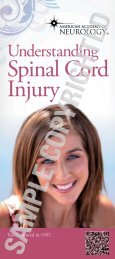Stroke - American Academy of Neurology
Stroke - American Academy of Neurology
Stroke - American Academy of Neurology
Create successful ePaper yourself
Turn your PDF publications into a flip-book with our unique Google optimized e-Paper software.
Life After <strong>Stroke</strong>Although some people recover fully after a stroke, othersmay have ongoing problems. These problems depend on thesize and location <strong>of</strong> the stroke and can include:• Problems with thinking and memory• Difficulty speaking or understanding• Difficulty swallowing• Emotional problems, such as depression• Loss <strong>of</strong> vision, <strong>of</strong>ten on one side• Loss <strong>of</strong> strength or feeling on one side <strong>of</strong> the body• Loss <strong>of</strong> balance and the ability to walkRehabilitation helps regain functions lost from damage dueto stroke. During rehabilitation, most people will improve—although many do not recover completely. The brain canlearn new ways <strong>of</strong> functioning by using undamaged braincells.Preventing a Second <strong>Stroke</strong>People who have had a stroke are at much greater risk foranother stroke than those who have never had one. Talkto your neurologist about ways to prevent a second stroke.These may include medications and changes to your lifestyleincluding:• Eating a diet low in salt, fat, and cholesterol• Controlling high blood pressure• Quitting smoking• Controlling cholesterol with drugs• Taking drugs that reduce blood clottingPartnering with Your NeurologistTo provide the best care, your neurologist needs to knowall about your symptoms and medical history. Likewise,you need to get answers to your questions. Keeping anotebook about your condition and bringing a few wellorganizedquestions to your appointments can be helpful.









